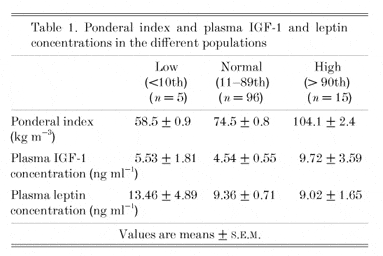Recent evidence has suggested that body shape may be a more important diagnostic indicator of future growth and development (Litten et al. 2001) than body weight alone. It is well documented that IGF-1 and leptin play important roles in the regulation of growth and energy metabolism. This study examined whether plasma concentrations of IGF-1 and leptin were influenced by body shape in adolescent pigs.
One hundred and sixteen pigs of differing body shapes were entered into the study at 3 months of age and fed ad libitum (Growlean OP meal, 14 MJ kg-1, BOCM, UK). Individual body weight and crown-to-rump length was measured fortnightly until 5-6 months of age to enable the ponderal index (PI: kg m-3) to be calculated. A blood sample was taken from each pig for subsequent determination of plasma IGF-1 and leptin concentration using human ELISA kits DSL-10-5600 and DRG EIA-1863, respectively, which had been previously validated for porcine samples (J.C.L.). A normal distribution curve of the PI was used to describe the distribution of the pig population (Low, < 10th, n = 5; Normal, 11-89th, n = 96; High, > 90th, n = 15). Differences in plasma IGF-1 and leptin concentrations were assessed using a General Linear Model. All experiments were carried out in accordance with current UK legislation.
The PI remained different (P < 0.001) between the subpopulations throughout the study (Table 1). Plasma IGF-1 was elevated in the High group (P < 0.05) but there were no differences in circulating levels of leptin between subpopulations. Growth rate was related to both IGF-1 and leptin plasma concentrations only in the Low group: growth rate = 2.82 – (0.137 IGF-1) – (0.084 Leptin); R 2 = 74.3 %.
In conclusion, body shape at 3 months can have a pronounced influence on plasma concentrations of IGF-1 and leptin in the adolescent pig. Differences in body conformation may in part be due to changes in nutrient partitioning as a result of the altered relationship between IGF-1 and leptin. This relationship may provide a useful indicator to predict future growth and development.
The authors would like to thank Cotswold Pig Development Company for their assistance in this study. J.C.L. is funded by a Wye College PhD studentship.

